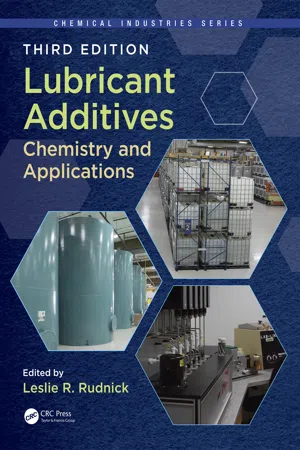
This is a test
- 693 pages
- English
- ePUB (mobile friendly)
- Available on iOS & Android
eBook - ePub
Book details
Book preview
Table of contents
Citations
About This Book
This indispensable book describes lubricant additives, their synthesis, chemistry, and mode of action. All important areas of application are covered, detailing which lubricants are needed for a particular application. Laboratory and field performance data for each application is provided and the design of cost-effective, environmentally friendly technologies is fully explored. This edition includes new chapters on chlorohydrocarbons, foaming chemistry and physics, antifoams for nonaqueous lubricants, hydrogenated styrene–diene viscosity modifiers, alkylated aromatics, and the impact of REACh and GHS on the lubricant industry.
Frequently asked questions
At the moment all of our mobile-responsive ePub books are available to download via the app. Most of our PDFs are also available to download and we're working on making the final remaining ones downloadable now. Learn more here.
Both plans give you full access to the library and all of Perlego’s features. The only differences are the price and subscription period: With the annual plan you’ll save around 30% compared to 12 months on the monthly plan.
We are an online textbook subscription service, where you can get access to an entire online library for less than the price of a single book per month. With over 1 million books across 1000+ topics, we’ve got you covered! Learn more here.
Look out for the read-aloud symbol on your next book to see if you can listen to it. The read-aloud tool reads text aloud for you, highlighting the text as it is being read. You can pause it, speed it up and slow it down. Learn more here.
Yes, you can access Lubricant Additives by Leslie R. Rudnick in PDF and/or ePUB format, as well as other popular books in Physical Sciences & Industrial & Technical Chemistry. We have over one million books available in our catalogue for you to explore.
Information
Section V
Miscellaneous Additives
15
Evaluating Tackiness of Polymer-Containing Lubricants by Open-Siphon Method
Experiments, Theory, and Observations
CONTENTS
15.1Introduction
15.2Experimental Setup, Procedures, and Fluids
15.3Viscoelastic Effects during Withdrawal of Tacky Lubricants
15.4Theoretical Model
15.5Experimental Results with a 0.025% PIB Solution: Comparison with the Theory
15.6Using the Open-Siphon Method for Evaluation of Tackiness of Lubricating Fluids
15.7Conclusion
Acknowledgment
References
15.1Introduction
A tackifier is a lubricant additive that imparts a tack or stringiness to a substance and is typically used to provide adherence in fluid lubricants and stringiness in greases. Tackifiers are used to inhibit dripping, removal, and flinging of lubricating oils and to impart texture in greases. In lubricant applications, most tackifiers are dissolved polymers in either mineral oil or vegetable oil–based diluents. The polymers are often polyisobutylene (PIB) with a molecular weight of 1000–4000 kDa or rarely an ethylene–propylene copolymer (OCP) with a molecular weight of approximately 200 kDa. The tackiness of a solution generally increases with polymer molecular weight. The operational environment of the lubricant dictates polymer selection; for example, in high mechanical shear and high temperature applications, OCPs are generally preferred over PIBs. The base oils may be paraffinic, naphthenic, or vegetable, depending upon application. Lubricant dripping, splashing, and aerosol formation (misting) are major problems for many lubricants. Tackifier additives in lubricating oils are useful in minimizing these problems. Application areas where lubricant retention and enhanced film thickness is benefited by tackifiers are open gear oils, slideway lubricants, wire ropes, textile operations, chain saws, chains, and rock drill oils. Tackifier additives in greases enhance the greases ability to stay in place and to resist removal by water in operation. Specialty applications include food grade, aerospace, and biobased lubricants.
Tackifier treat rates range from 0.02% in antimist applications to 3% or more in grease applications. A key challenge among manufacturers and users of tackifiers is to evaluate and compare tackifier formulations in a systematic and repeatable manner. This chapter provides a theoretical foundation and practical test method to address this challenge.
In many industrial applications, the lubricating oil must not drip or mist from the surfaces to be lubricated. This can be practically achieved by increasing the cohesive energy of the lubricating fluid in order to prevent atomization. The oil viscosity should remain as low as possible to prevent excess wasted energy. In this case, the properties of the optimal lubricating oil should be stringy to prevent oil loss and increase lubrication lifetime for machinery in which oil waste is a problem. To satisfy the earlier industrial need, the lubricating industry has formulated and utilized lubricating oils containing tackifiers. Typical formulations of tacky lubricants are limited to high-molecular-weight PIB dissolved in petroleum oil.
For polymer solutions to be tacky, the polymer chains should have the capacity to extend and thus behave as viscoelastic liquids. To be less viscous and reduce cost, tackifiers should be very dilute solutions of high-molecular-weight polymer in base fluid. It is well known that the viscoelastic properties of polymer solutions depend on polymer concentration and several molecular parameters of the polymer determined by the chemical structure [1,2,3]. The most important parameters are the polymer molecular weight and, to a lesser degree, the molecular weight distribution, and the flexibility of the polymer chains. The chain flexibility is responsible for uncoiling of chains with smaller Kuhn segments, and, for more r...
Table of contents
- Cover
- Halftitle Page
- Series Page
- Title Page
- Copyright Page
- Contents
- Preface
- Contributors
- SECTION I Deposit Control Additives: Oxidation Inhibitors
- SECTION II Film-Forming Additives
- SECTION III Antiwear and Extreme Pressure (EP) Additives
- SECTION IV Viscosity Control Additives
- SECTION V Miscellaneous Additives
- SECTION VI Applications
- SECTION VII Trends
- SECTION VIII Methods and Resources
- Appendix A: Grease Compatibility Chart
- Appendix B: Color Scale Comparison Chart
- Appendix C: ISO Viscosity Ranges
- Index